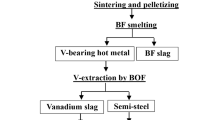Abstract
In this work, vanadium is extracted from TiCl4 refining tailings by a clean metallurgical process and FeVO4 is prepared by adjusting the pH of acid leaching solution. The main factors affecting the leaching of vanadium from tailings are leaching temperature, solid-to-liquid ratio, hydrochloric acid concentration and type of oxidant. Under the optimal leaching conditions, when the leaching temperature is 30°C, the solid-liquid ratio is 1 : 4, the hydrochloric acid concentration is 400 g/L, and the oxidant is H2O2, the leaching rate of V can reach 97.1% after 60 min of reaction. The main factors affecting the precipitation of FeVO4 are the precipitation temperature, the initial vanadium concentration, the pH endpoint value of acid leaching solution and the addition amount of H2O2 oxidant. Under the optimal precipitation conditions, when the precipitation temperature is 40°C, the initial vanadium concentration is 5 g/L, the pH endpoint value of the acid leaching solution is 1.4, the addition amount of H2O2 oxidant is 6%, the precipitation rate of V can reach 95.4% after 60 min. By adjusting the pH value of precipitation filtrate, metal ions such as Fe, Al, Ca and Mg precipitate to form neutralization slag. The neutralization filtrate can be prepared NaCl crystals by evaporation crystallization, and the mother liquor of evaporation crystallization is returned to acid leaching for use. Acid leaching residue (TiO2 content is 55.42%) can be recycled as high-titanium raw material. This study can properly deal with the environmental pollution caused by the stacking of TiCl4 refining tailings.














Similar content being viewed by others
REFERENCES
Zhang, Ym., Wang, Ln., Chen, Ds., et al., A method for recovery of iron, titanium, and vanadium from vanadium-bearing titanomagnetite, Int. J. Miner., Metall. Mater., 2018, vol. 25, pp. 131–144. https://doi.org/10.1007/s12613-018-1556-0
Yang, St., Zhou, M., Jiang, T., et al., Application of a water cooling treatment and its effect on coal-based reduction of high-chromium vanadium and titanium iron ore, Int. J. Miner., Metall. Mater., 2016, vol. 23, pp. 1353–1359. https://doi.org/10.1007/s12613-016-1358-1
Liu, X., Wang, X., Wang, M., et al., Selective removal of the impurity silicon and aluminum in titanium concentrate, Rare Met. Technol., 2016, vol. 36, pp. 167–174. https://doi.org/10.1007/978-3-319-48135-7_17
Tang, Wd., Yang, St., Zhang, Lh., et al., Effects of basicity and temperature on mineralogy and reduction behaviors of high-chromium vanadium–titanium magnetite sinters, J. Cent. South Univ., 2019, vol. 26, pp. 132–145. https://doi.org/10.1007/s11771-019-3988-8
Fatollahi-Fard, F. and Pistorius, P.C., Impurity removal from titanium oxycarbide, in TMS 2017 146th Annual Meeting and Exhibition Supplemental Proceedings, Cham: Springer, 2017, pp. 629–636. https://doi.org/10.1007/978-3-319-51493-2_60.
Dmitrieva, N.G., Romodanovskii, P.A., Gridchin, S.N., et al., The enthalpies of solution of VOCl3 in dilute solutions of sodium hydroxide and the standard enthalpy of formation of liquid VOCl3, Russ. J. Phys. Chem. A, 2010, vol. 84, pp. 143–145. https://doi.org/10.1134/S0036024410010280
Liang, L., Kaihua, L., Qingdong, M., et al., Research on quality improvement of titanium sponge by process optimization, Rare Met. Technol., 2015, vol. 37, pp. 231–237. https://doi.org/10.1007/978-3-319-48188-3_26
Wu, S., He, Xb., Wang, Lj., et al., High Cr(VI) adsorption capacity of rutile titania prepared by hydrolysis of TiCl4 with AlCl3 addition, Int. J. Miner., Metall. Mater., 2020, vol. 27, pp. 1157–1163. https://doi.org/10.1007/s12613-020-1965-8
Kado, Y., Kishimoto, A., and Uda, T., New smelting process for titanium: magnesiothermic reduction of TiCl4 into liquid Bi and subsequent refining by vacuum distillation, Metall. Mater. Trans. B, 2015, vol. 46, pp. 57–61. https://doi.org/10.1007/s11663-014-0164-2
Ivanov, I.I., Dubovikov, O.A., Grigor’eva, L.V., et al., Study of stability of constructional materials in melts containing lower titanium chlorides, Russ. J. Appl. Chem., 2011, vol. 84, p. 1529. https://doi.org/10.1134/S1070427211090126
Ghiyasiyan-Arani, M., Salavati-Niasari, M., Masjedi-Arani, M., et al., An easy sonochemical route for synthesis, characterization and photocatalytic performance of nanosized FeVO4 in the presence of aminoacids as green capping agents, J. Mater. Sci.: Mater. Electron., 2018, vol. 29, pp. 474–485. https://doi.org/10.1007/s10854-017-7936-9
Ou, X., Yan, J., Zhang, F., et al., Accelerated degradation of orange G over a wide pH range in the presence of FeVO4, Front. Environ. Sci. Eng., 2018, vol. 12, p. 7. https://doi.org/10.1007/s11783-018-1013-3
Sajid, M.M., Shad, N.A., Javed, Y., et al., Facile synthesis of Zn3(VO4)2/FeVO4 heterojunction and study on its photocatalytic and electrochemical properties, Appl. Nanosci., 2020, vol. 10, pp. 421–433. https://doi.org/10.1007/s13204-019-01199-8
Mosleh, M., Nanocrystalline iron vanadate: facile morphology-controlled preparation, characterization and investigation of optical and photocatalytic properties, J. Mater. Sci.: Mater. Electron., 2017, vol. 28, pp. 5866–5871. https://doi.org/10.1007/s10854-016-6259-6
Bovina, A.F., Gudim, I.A., Eremin, E.V., et al., Growth and characterization of Fe1−xMxVO4 single crystals (M = Al, Cr, Co, Ga), Crystallogr. Rep., 2012, vol. 57, pp. 955–958. https://doi.org/10.1134/S106377451207005X
Funding
This research was supported by the National Natural Science Foundation of China (51874094), the Basic scientific research business expenses of Northeastern University (N182502041).
Author information
Authors and Affiliations
Corresponding author
Ethics declarations
The authors declare that they have no conflict of interest.
About this article
Cite this article
Jinwei, Q., Tingan, Z., Liping, N. et al. A Novel Technology to Prepare FeVO4 from TiCl4 Refining Tailings. Russ. J. Non-ferrous Metals 62, 157–164 (2021). https://doi.org/10.3103/S1067821221020127
Received:
Revised:
Accepted:
Published:
Issue Date:
DOI: https://doi.org/10.3103/S1067821221020127




